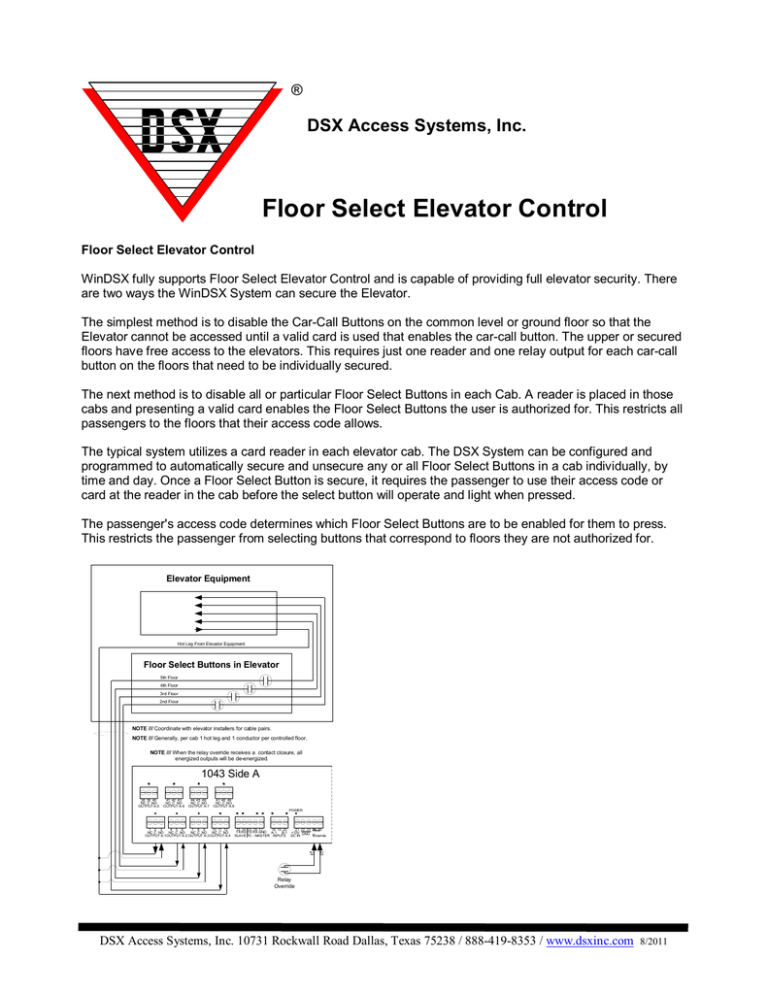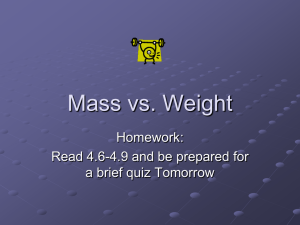Floor Select Elevator Control
advertisement

® DSX Access Systems, Inc. Floor Select Elevator Control Floor Select Elevator Control WinDSX fully supports Floor Select Elevator Control and is capable of providing full elevator security. There are two ways the WinDSX System can secure the Elevator. The simplest method is to disable the Car-Call Buttons on the common level or ground floor so that the Elevator cannot be accessed until a valid card is used that enables the car-call button. The upper or secured floors have free access to the elevators. This requires just one reader and one relay output for each car-call button on the floors that need to be individually secured. The next method is to disable all or particular Floor Select Buttons in each Cab. A reader is placed in those cabs and presenting a valid card enables the Floor Select Buttons the user is authorized for. This restricts all passengers to the floors that their access code allows. The typical system utilizes a card reader in each elevator cab. The DSX System can be configured and programmed to automatically secure and unsecure any or all Floor Select Buttons in a cab individually, by time and day. Once a Floor Select Button is secure, it requires the passenger to use their access code or card at the reader in the cab before the select button will operate and light when pressed. The passenger's access code determines which Floor Select Buttons are to be enabled for them to press. This restricts the passenger from selecting buttons that correspond to floors they are not authorized for. Elevator Equipment Hot Leg From Elevator Equipment Floor Select Buttons in Elevator 5th Floor 4th Floor 3rd Floor 2nd Floor NOTE /// Coordinate with elevator installers for cable pairs. NOTE /// Generally, per cab 1 hot leg and 1 conductor per controlled floor. NOTE /// When the relay override receives a contact closure, all energized outputs will be de-energized. 1043 Side A 38 39 40 NC C NO OUTPUT A:5 41 42 43 NC C NO OUTPUT A:6 44 45 46 NC C NO OUTPUT A:7 47 48 49 NC C NO OUTPUT A:8 POWER 1 2 3 4 5 6 7 8 9 10 11 12 NC C NO NC C NO NC C NO NC C NO OUTPUT A:1OUTPUT A:2 OUTPUT A:3 OUTPUT A:4 13 14 15 16 17 21 22 23 24 25 18 19 20 Rela TX RX TX RX GND A:1 B:1 +12V SLAVE PC - MASTER INPUTS DC IN GND yOverride Relay Override DSX Access Systems, Inc. 10731 Rockwall Road Dallas, Texas 75238 / 888-419-8353 / www.dsxinc.com 8/2011 If the elevator system is so equipped, it is possible to receive a contact closure from the elevator equipment to indicate and record which Floor Select Button is pressed. The Outputs from the elevator equipment connect to one of the inputs on the DSX panel to record which Floor Select Button the user pressed and to reset any additional buttons that may have been enabled by the user's access code. This keeps a tag-along from pressing a Floor Select Button that someone else's code enabled. Floor Select Monitoring is facilitated by assigning the inputs to a reader as shown below. This enables the Floor Select Elevator Reports in History to show who pressed what Floor Select Button in a secure cab. Car Call Monitoring Car Call Buttons can also be enabled and disabled by time and day and enabled by a user at a reader or keypad in close proximity to the elevator on all restricted floors. Any combination of car call and floor select restrictions may be designed and implemented to meet the specific access needs of the user. With the flexibility that code linking gives the System, each user's access code can enable different floors and devices, depending on where, or in which cab, time of day and day of week, the code is used. Floor select elevator control can always be overridden at the PC. Floor Select and Car Call Buttons are secured by the Time Zones assigned to the DSX outputs they are interconnected with. Up to four Time Zones can be assigned to each output. This provides up to four secure periods per day for each button. This also allows some floors to secure at different times than others, which is especially useful in multi-tenant buildings. Some floors such as the ground floor do not always need to be secured. Typically there is at least one floor select button per cab that everyone has access to. Linking Levels are used to determine cardholder access to the Floor Select and/or Car Call Buttons. The Access Level still determines which reader or keypads and at what days and times the cardholders card will be granted access. Once the cardholder is granted access, their Linking Level determines which Floor Select and /or Car Call Buttons will be enabled for the user to press. Linking Levels are managed through the WinDSX software with a simple but flexible approach. Every output is placed in a Linking Group by itself and given a name such as “East Elevator Cab - Floor 2” “…Floor 3” and so on. When defining a Linking Level using the WinDSX Linking Level Manager, shown below, first select the reader or keypad the card holder would be using and then select each Linking Group (Floor Select Button) to be activated (enabled) when their code is used at that reader. The Linking Groups selected are those that correspond to the Floor Selection and/or Car Call Buttons this Cardholder should have access to and permission to push. Then within the same Linking Level definition, select the next reader this linking level should work at, such as the next elevator cab, followed by all of the linking groups that should be activated from an access granted at that reader. DSX Access Systems, Inc. 10731 Rockwall Road Dallas, Texas 75238 / 888-419-8353 / www.dsxinc.com 8/2011 Elevator Control Output Linking Level Manager Each Output in the Linking Group has a Time Zone that determines what times and days the output will activate when linked to. This provides a means to give different cardholders or even the same card holder different windows of access, (defined by time and day), for each Floor Select Button. The following describes the materials needed for Elevator Control with the DSX System: One DSX-1042 /1022 Controller for every two readers required. The DSX-1020 Controller provides 1 reader and is efficient when the controller is located on the elevator cab instead of the control or equipment room. Also needed to complete the interface is one relay output for every Floor Select and Car Call Button to be secured. Use any of the following or combinations thereof to achieve the correct number of outputs and readers. DSX-1042 Intelligent Controller (2 relays) (2 readers) DSX-1022 Intelligent Controller (4 relays) (2 readers) DSX-1020 Intelligent Controller (2 relay) (1 reader) DSX-OX4 Output Extender (4 relays) DSX-1043 Output Controller (16 relays) The DSX-OX4 and the DSX-1043 Output Extenders can be connected to DSX-1042, and DSX-1022 Controllers. Only one extender per panel is allowed. Readers attached to the DSX-1042 and 1022 Controllers can activate relays on any controller or output extender in the system. This operation is indicative of the Global Code-to-Linking Logic feature available with the WinDSX System. DSX Access Systems, Inc. 10731 Rockwall Road Dallas, Texas 75238 / 888-419-8353 / www.dsxinc.com 8/2011 Location Partitioning for Elevator Control Floor Select Elevator Control should be partitioned into a Location separate from the door controllers. In a large system with high traffic Floor Select Control and Monitoring should be grouped so that each of the risers – Low, Mid, and High should each be a separate location as well as any parking structures. Designing the system in such a manner allows for orderly additions and upgrades. Typical Connection DSX Access Systems, Inc. 10731 Rockwall Road Dallas, Texas 75238 / 888-419-8353 / www.dsxinc.com 8/2011


